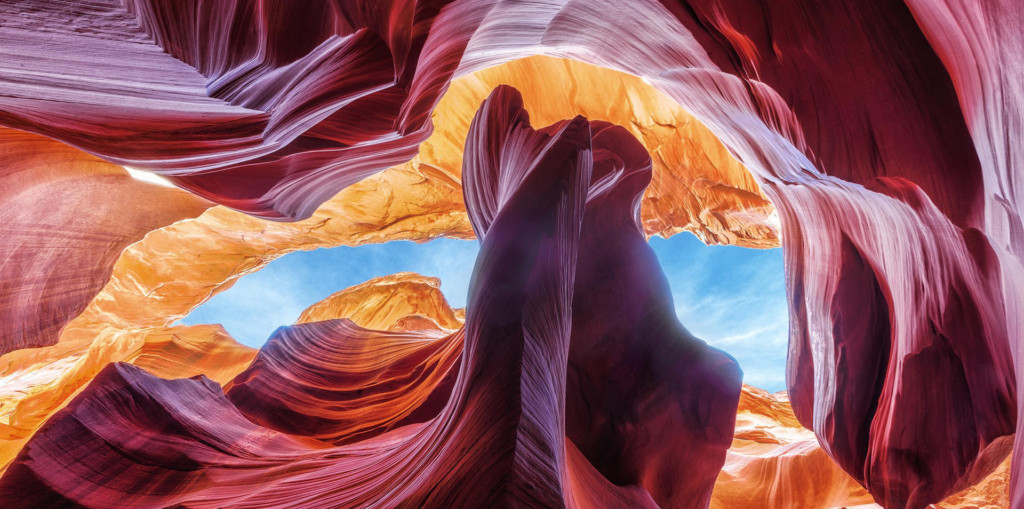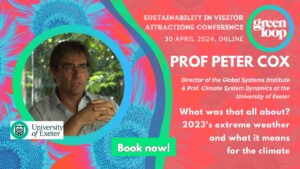As human beings we are hardwired to respond to the natural environment. Designers from PGAV Destinations share their favourite inspirations from the natural world.
The relationship between nature and destinations is easy to forget when we spend so much of our time inside climate-controlled buildings, staring at screens. Former Microsoft research fellow Alex Soojung-Kim Pang says most workers manage to work uninterrupted for 15-minute stretches at the most (and for many of us it’s as little as three minutes). The rest of the time we’re emailing, texting, surfing, networking, and in various ways, getting pinged. Constantly distracted, we wear ourselves out trying to focus and pay attention. Our breathing gets shallow, and our concentration drifts.
At Stanford University, researchers found that nature walks decreased people’s tendency toward “rumination”—a compulsively negative way of thinking that’s been tied to increased risk of depression. At the University of Chicago, researchers found that “having ten more trees in a city block, on average, improves health perception in ways comparable to an  increase in annual personal income of $10, 000 and moving to a neighborhood with $10, 000 higher median income or being seven years younger.” And a study published in Health & Place suggested that trees even protect our hearts: older women had a 25 percent higher risk of suffering a heart attack, stroke, or fatal heart disease when they lived in places where emerald ash borer infestations had abruptly killed off large numbers of trees. Yet Harvard University’s Center for Health and the Global Environment predicts that by 2030, 86 percent of developed nations’ population will live in cities, most of them starved for green space.
increase in annual personal income of $10, 000 and moving to a neighborhood with $10, 000 higher median income or being seven years younger.” And a study published in Health & Place suggested that trees even protect our hearts: older women had a 25 percent higher risk of suffering a heart attack, stroke, or fatal heart disease when they lived in places where emerald ash borer infestations had abruptly killed off large numbers of trees. Yet Harvard University’s Center for Health and the Global Environment predicts that by 2030, 86 percent of developed nations’ population will live in cities, most of them starved for green space.
The shift won’t change our craving for nature—that need is instinctive, almost impossible to erase. In Kinship to Mastery: Biophilia in Human Evolution and Development, social ecologist Stephen Kellert points out how consistent our response to nature is, across cultures and generations. We’re drawn by its harmony and order, its promise of sustenance and security, its mystery and wonders, its ability to heal and restore us.
The following is a small excerpt from PGAV Destinations’ Inspiration from Nature, highlighting the top eight climes and destinations featured in the narrative which explores how destinations designers draw inspiration from nature to create remarkable attractions. To order a free copy of the full publication, visit https://www.pgavdestinations.com/Insights.
Reconnecting
Nature brings us back to ourselves. It reconnects us to the world around us and restores our body’s natural state. Shaded by towering redwoods or walking barefoot on a pink-sand beach, we relax our muscles, think a little more clearly, breathe a little more deeply. Nature’s soundscapes (think of birdsong or a babbling brook) have a layered complexity that delights our ear. And a forest’s deep silence is a rare relaxation in our beeping, chiming, droning world.
The idea behind the 1859 Balloon Voyage at Conner Prairie was to let visitors rise up into the sky and gain an entirely new perspective on the land beneath them. Conner Prairie’s hardwood forests were chopped down to build the city of Indianapolis, their rough-hewn oak sawed and sanded and shipped to other new settlements. Now the trees have grown back as a dense, deep green forest, edging one of the last good examples of prairie in the region.
Wilderness
We need ways to prove our mettle, whether it’s staring down a rhinoceros, climbing into the thin air of the highest altitudes, or venturing off the hiking trail. When we arrive back where we started, whole and sound, our knees buckle with sweet, cathartic relief. But there’s also an ego rush, an exhilarated pride in triumphing over what might have crippled us. And our bodies have had their own, neurochemical rush, as adrenaline and dopamine course through our bloodstream. That high can be addictive. Everything else in life drops away, and both the past and the future cease to matter. Time slows to a crawl, and we remember what it’s like to focus with our whole brain engaged.
Conscious of people’s hunger to get closer to nature, PGAV VP Tom Owen reflects on master planning the surrounding area of the Niagara Falls Table Rock Welcome Center: “The Niagara Parkway runs through some beautiful nature areas, and you can follow the water as it crashes through a gorge. The force of the water in that narrow channel almost makes you swoon. It flows into a whirlpool a mile across. Fewer people venture out to the whirlpool, so you can have narrower paths, a simple wood-plank walkway. You don’t have to tame it so much—you can preserve that sense of wildness.”
Water
Water cleans us, cools us, slakes our thirst. We turn playful when immersed: Waterfalls and whitewater send a zing of excitement through our body, and even a fountain is fun to splash around in. We shower under “rain” settings and fall asleep to thunderstorm recordings. The unceasing rhythm of ocean waves calms us, and the tide’s power awes us. Freud had good reason for naming a psychological sense of wholeness and eternity “the oceanic feeling.”
But more practically, water reassures us because it promises fertility and sustenance. Add a simple water feature, even indoors, and we begin to react to buildings and plazas as though they are green space. And because shininess and motion are two of the qualities that draw the human eye, sun glinting on waves is almost impossible to resist.
From the pebble-strewn banks of babbling brooks, to the glistening white sands at the foamy edge of ocean surf, to silent and motionless glacial lakes high in the mountains, life springs forth from the shores of water. With the grand lake at the center of Chimelong Ocean Kingdom, celebrating the world’s bodies of water, plants and animals – both real and artistically imagined – are bountiful throughout the park.
Landscapes
Harvard biologist E.O. Wilson believes that like all other animals, we’re drawn to wildlands with certain characteristics—most especially the African savannah where our species took form. Wilson recently commented to Washington Post that people say, “I go there and in a short while, I feel somehow completely at home.” Gordon Orians, an evolutionary biologist, put forth his now famous savannah hypothesis to explain how our attraction to certain landscapes—even trees of certain shapes, like the gracefully spreading, shade-giving acacia tree—took hold when human beings moved from forest to grassland. To this day, we like open spaces and long vistas. And even preschoolers consistently choose acacia-like trees as the most inviting, offering the greatest sense of security.
For its audience, the ceremony’s almost boring. Every year since 1990, Busch Gardens Williamsburg has been pronounced the World’s Most Beautiful Theme Park by the National Amusement Park Historical Association. And just as Grammy Award winners thank their piano teachers, Busch Gardens thanks its trees. The park grew out of the Virginia countryside and is nestled in lush forest, its European villages tucked between stands of 80-foot oak trees or set against a backdrop of evergreens. Framed, they make visual sense, and it’s easy to orient yourself and navigate among them. PGAV used Williamsburg’s natural features to organize the park, soften its edges, muffle its exuberance.
“The topography required that a lot of the pathways and train tracks run on bridges that cross the lake, ” PGAV VP Jeff Havlik says. “As you walk across, you can stop and look out at tree-lined valleys, ” which adds a new vantage point and fresh details. And because all the European villages are separated from each other, distinct experiences unto themselves, “there are nature walks between each village. When you’re in, say, England, you don’t see the rest of the park.” Clever use of the trees made sure nothing was visually intrusive; nothing broke the imagination’s spell.
Vantage Points
Whether we climb to the summit of Mount Kilimanjaro, zip through a tree canopy, or just take an elevator to a spinning glass-walled restaurant atop a hotel, we’re thrilled by any vantage point that lets us see far and wide. “The analogy of scraping the sky, and so getting closer to heaven, resists dismissal, ” Mark Kingwell writes of the Empire State Building.
Why do we love high places? Because we are earthbound, and we move through our lives horizontally. Going vertical means transcending our limits—witness the spires of gothic cathedrals and ambitious secular skyscrapers. We risk our lives to climb mountains that have endured for millennia and hold secrets we cannot fathom.
When you visit the Kennedy Space Center, your first glimpse of the NASA Space Shuttle Atlantis happens with a flourish, as the screen of a multimedia show opens to reveal the shuttle itself. Its backdrop? An LED screen that shows image after image of the shuttle’s view from space. No words needed. “We create a sunrise, and you can see the light change across the shuttle, ” says Doug Nickrent, PGAV Senior Exhibit Designer. “Some of the imagery takes you from day to night in orbit, which happened every 90 minutes for them. There’ll be this glorious sunset, and afterward the lights start popping up on Earth, and you realize the speed at which the shuttle orbited. There are rare views of the ozone layer and the horizon and the ice caps. Stunning time-lapse images of the Aurora Borealis taken from the space station…”
Nickrent grins—the wonder of it hasn’t left him, never will. “We so quickly get used to these things that when you stop and think about them are freakin’ amazing. Almost without exception, every astronaut talks about the fact that you can’t see any borders from space. When you are looking down at Earth, it’s not a map drawn with little lines that people fight over. It’s not that sphere we all saw in our classrooms, stuck on an axis that only spins one way. It’s a blue globe of water.
Extreme Terrain
Pound a mountain’s rock into sand and stretch it flat for what seems an infinity, and it takes on a new meaning. Vast as the night sky, desert’s a stark reminder that not all of the universe was designed to meet our needs. A harsh landscape, it can be our enemy, reminding us how vulnerable and tenuous our lives are. Extreme landscapes quiet the ego. Instead of every little failure and triumph altering our sense of worth, we find none of it matters all that much. We are tiny and temporary, and we can ease our heart’s burdens to the ground and rest a while. Such places are what the ancient Greeks called chora. Not mundane places, topos, but places charged with extra energy. The root of choreography, chora suggests meaningful arrangement, a place patterned to tell a story.
When you enter Antarctica: Empire of the Penguin, you’re at SeaWorld Orlando, sweating in the steam of 90 degrees with 90 percent humidity. Then you come upon a blindingly white glacier, a 40-foot white mountain shadowed in blue and slick with acrylic ice. “No trees, ” notes Project Architect Justin Stichter, “because this is an extreme environment.” A shiver runs down your spine even before you step inside. And the minute you do, you hear and smell 150 penguins. “It’s actually quite loud, ” Stichter observes. “They’re chatty.” The exhibit has no real barriers, just a bit of clever filtration to soften the fragrance of all that oily-fish consumption. An Emperor penguin plops into the water and you get splashed. Arctic wind blows in your face, and the temperature begins (kindly, gradually) its slide down to 40 degrees.
Animals
It’s called biophilia, this innate bond we feel with other living creatures. Our hearts melt at the sight of a young creature with a rounded face, soft features, and large eyes—whether it’s a toddler, a golden retriever pup, or a baby sea otter. And when they’re grown, animals continue to fascinate us. We invite them into our families and observe them in their own, recognizing what we hold in common. After all, we share much of the same DNA, and our brains share many of the same neurochemicals. We’re hardwired to respond to other animals, and the affinity reaches into the most ancient part of our brain. The impulse is primal—but it’s also cognitive. We enjoy figuring out what’s going on in the mind of a creature unlike ourselves, connecting across species lines. “The animals we seem to love the most, ” says Dr. Alexandra Horowitz, an animal cognition researcher, “are the ones that make expressions at us.”
People missed the Columbus Zoo and Aquarium’s giraffes and zebras so woefully, the zoo promised to bring them back. In Heart of Africa, PGAV Vice President John Kemper set out to create a savannah. His team found trees as close to acacias as Ohio’s harsh climate would allow, and giant paddocks created wide open vistas with very few perceivable boundaries.
Now, when a giraffe curls its long tongue around a branch and methodically strips off the leaves, visitors aren’t watching through bars. They can hear a lion’s throaty murmur or clock a warthog’s surprising speed. For authenticity, the big cats’ enclosure is layered in front of the giraffes, zebras, and wildebeests that would be their prey in the wild. There’s a common “watering hole” where the cheetahs come to chase lures, showing off their speed and agility, or romp with Anatolian shepherd dogs with whom they’re raised. When they finally wear out and return to their enclosure, the ostriches might show up at the watering hole, or a few giraffes might gallop in hoping for a handout.
Gardens
To this day, brightly colored flowers lure us with a double promise: beauty plus the presence of fruit, berries, squash, or nuts. The fragrance that helps the flowers attract bumblebees also resonates in our psyche. Smell is our freshest sense (its neurons replace themselves every 30 days), and scents cut straight to the emotional part of our brain, forming robust memories. A garden’s birdsong also has both poetic and prosaic associations, signaling a lush, verdant landscape with plenty of water, sunshine, forage, and shelter, and no harsh extremes of climate to endanger us. Cultivating veggies and grains allowed us to build stable, agrarian societies. But flowers are magic we coax from the earth. They drug us to sleep, intoxicate us, speak our love. The green of their leaves is the color of balance, centered on the color spectrum, and striking our eye in a way that requires no optical adjustment and is therefore entirely restful. Nature’s bright green calms us more effectively than any other color, a study in the March 2007 Journal of Physiological Anthropology found.
The concept for Discovery Cove was simple: Take people away to a tropical paradise. “It’s making people feel, the minute they step inside the resort, like they’re not in Orlando anymore, ” says Landscape Architect Dan O’Neill. The progression starts with a frisson of excited anticipation as you walk into a large, thatched building with wicker furniture and a relaxed resort feel. As soon as you come out the other side, “your view is framed across lagoon pools and sandy beaches. The landscape sets multiple backdrops so you have this sense that it goes on and on.” O’Neill’s team used bent palms that look like they’re leaning close to hear you whisper; giant ficus trees; short bromeliads bursting with red flowers; potted plants that pop with bright color and bring scale to the guest path. “The larger-leafed plants make it feel lush, already overgrown the day the park opened.” The concrete of the path looks muddy and sandy right where jungle and beach meet. Right after the overview, you meander down a winding path that takes you through an overgrown jungle, and you get a sense of exploration, journey and adventure.
To order a free copy of the complete PGAV Destinations’ Inspiration from Nature, visit https://www.pgavdestinations.com/Insights.
Images: PGAV Destinations
































